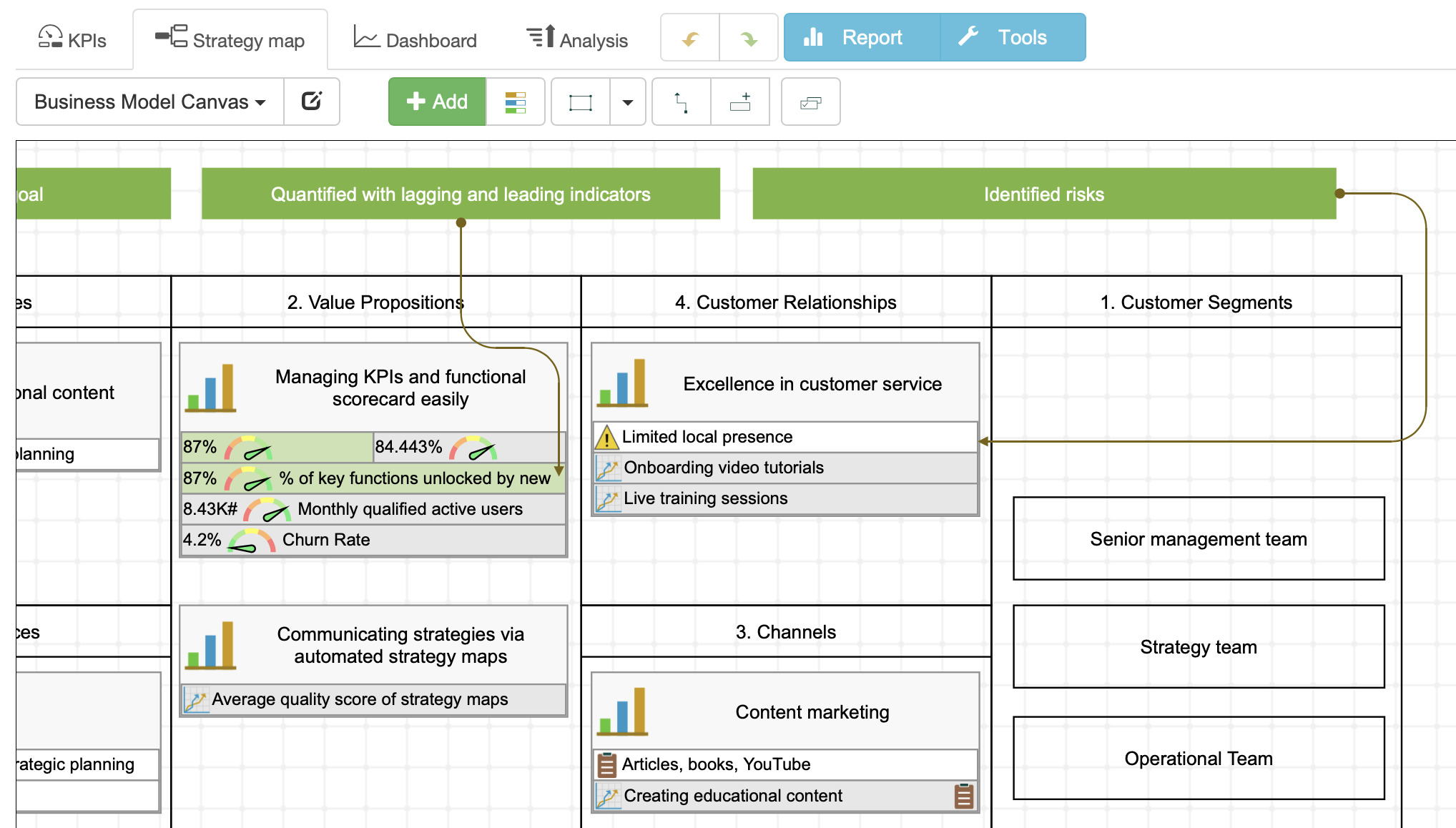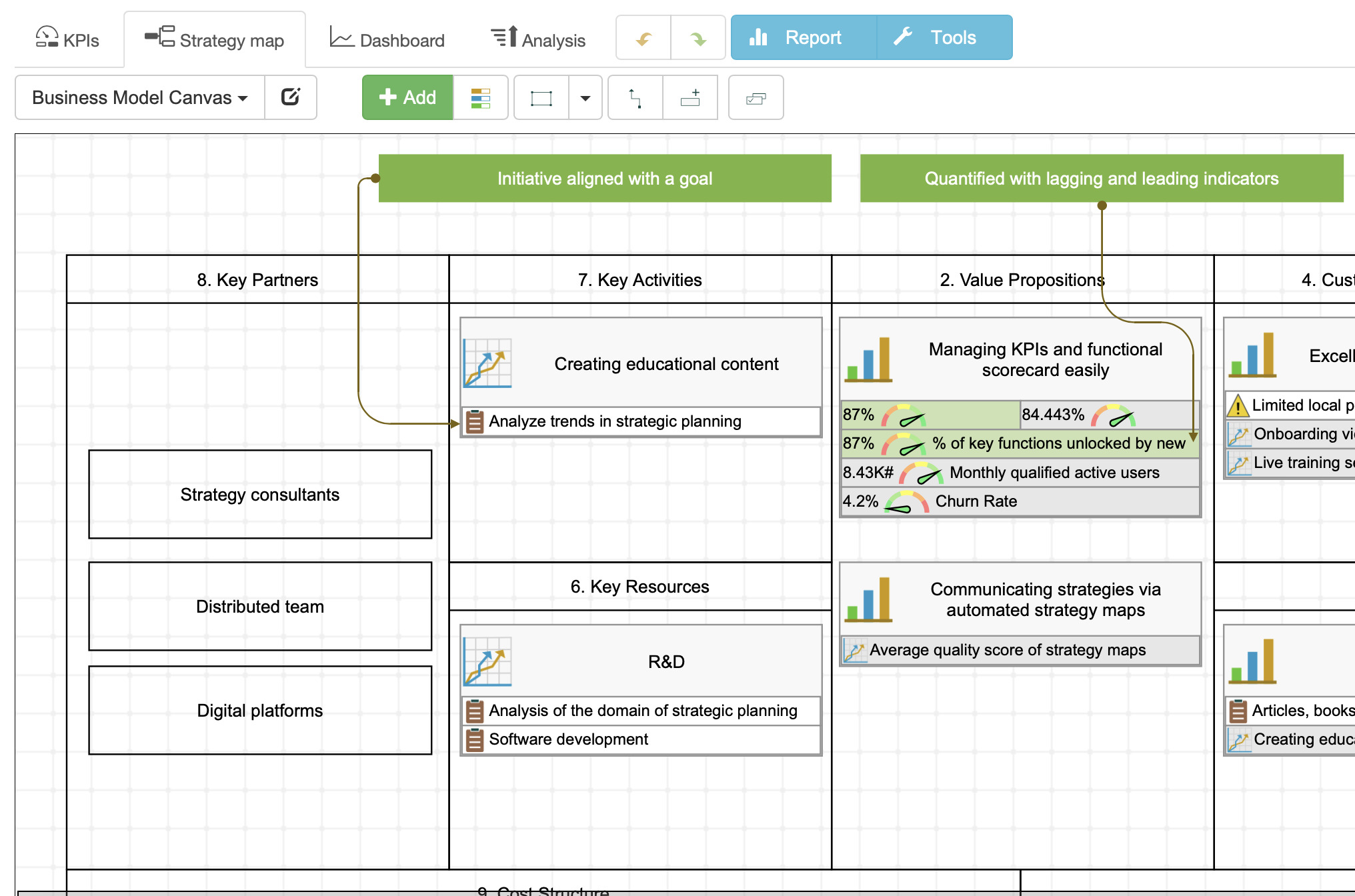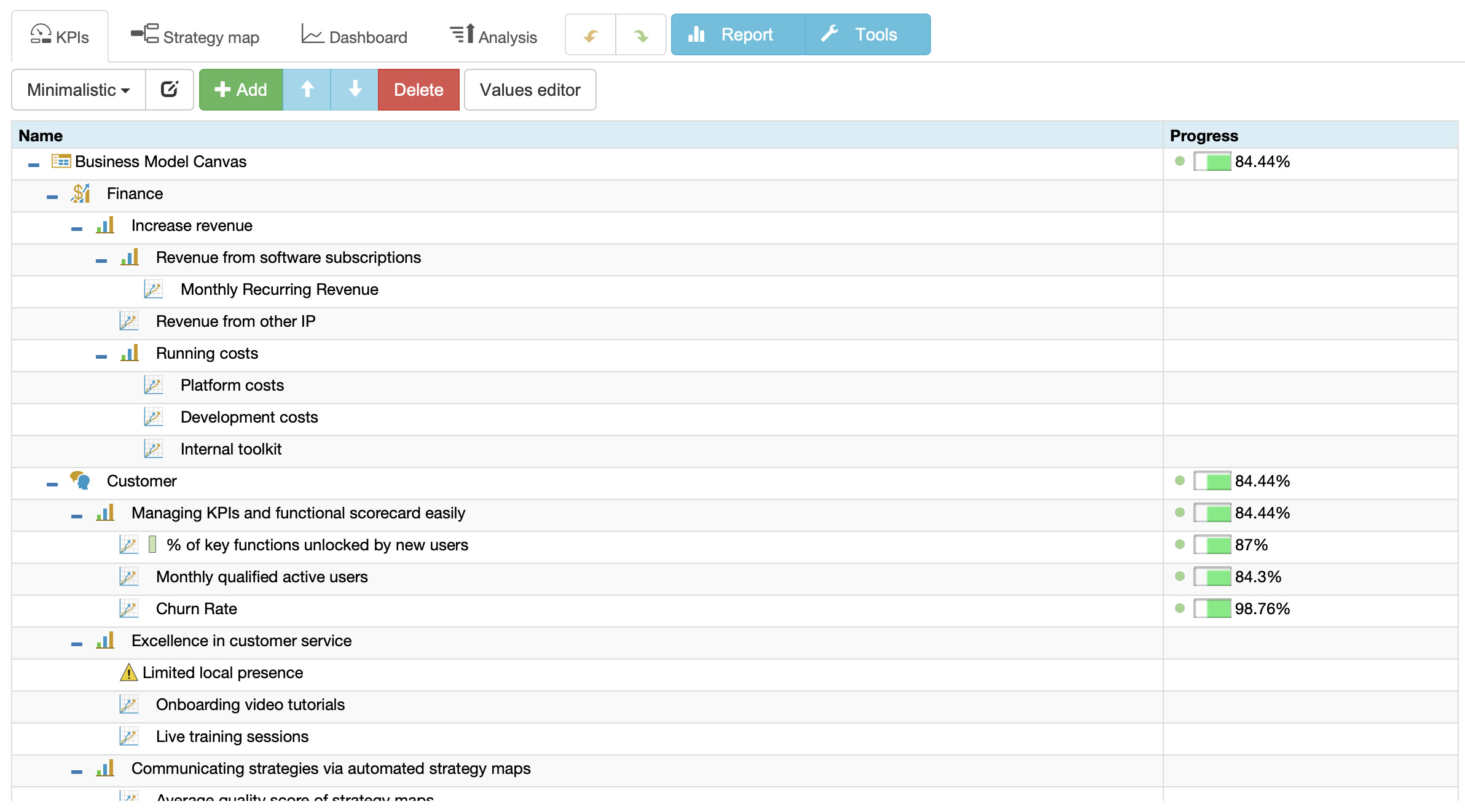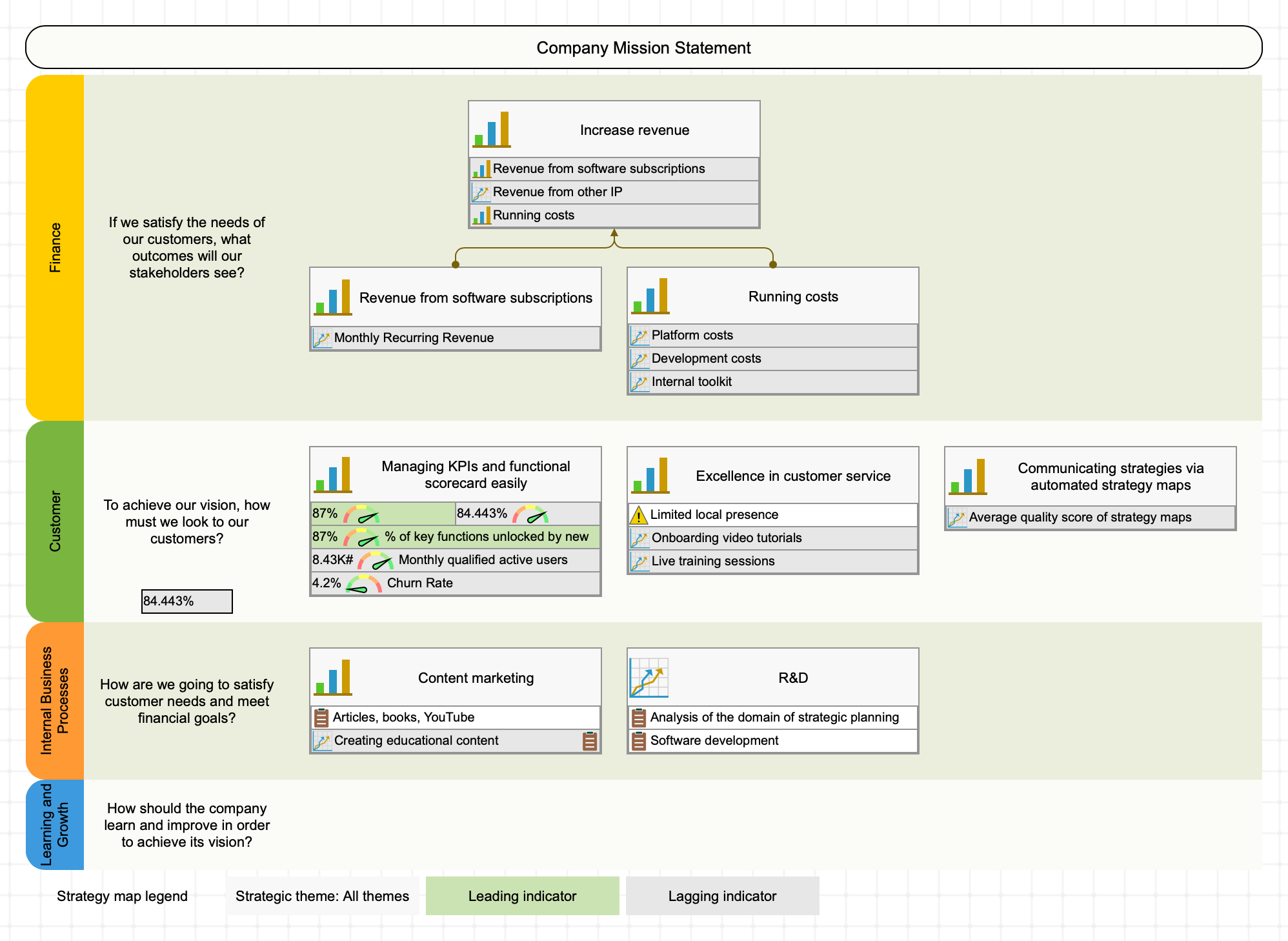An example of how to create a strategy map using the nine segments of the Business Model Canvas as a starting point.

What is Business Model Canvas?
Introduced by Strategyzer, the Business Model Canvas is a way to do a decomposition of a business model into 9 segments.
The business model presented on the canvas with standardized sections is easier to:
- Analyze
- Communicate, and
- Compare to other business models

Business Model is Not a Strategy
Formally, business model and strategy are two different things.
- Any strategy starts with some business model in mind.
- At any point of time, we can pause strategy execution and describe the current business model of the organization – it will be slightly different compared to what we had in a previous reporting period.
When new factors hit the business environment, the business model evolves. For example, the needs of the customers could change, or the operations could be affected by some uncertainty… We shift to the “strategy mode” again, where we’ll need to work with hypotheses and validate them via execution.
- Business model shows how business creates value
- Strategy shows how to change and compete
So, what comes first – the business model or business strategy? It is a little bit a chicken and egg question, as any strategy is created with some business model in mind and vice versa.
Matching Business Model Canvas with Strategy Map
The K&N Balanced Scorecard is one of the recognized frameworks for strategy description and execution. Let’s see how the 9 segments of the Business Model Canvas match the perspectives of the Balanced Scorecard’s strategy map.
| Segment of the Business Model Canvas | Perspective of the Balanced Scorecard | |
|---|---|---|
|
> | |
|
> | |
|
> | |
|
> |
Stakeholders
A strategy is built around the interests of the stakeholders. We typically start with these key types of stakeholders:
- Customers
- Employees
- Suppliers
- Communities
- Investors
| Segment of the Business Model Canvas | In Strategic Planning |
|
Stakeholders |
On the Business Model Canvas, the Customer segments (1) and the Key Partners (8) can be related to the stakeholders and their interests.
Financial Perspective
On the Balanced Scorecard, we have a perspective called Finance, or in general case, Stakeholders’ Interests.
The best match on the Business Model Canvas is the Revenue Streams (5) and Cost Structure (9) segments that explain what type of revenues business generate.
Matching Challenge: Dualism of the Concepts
In some cases, the match between the segments of the Business Model Canvas and the Balanced Scorecard might look counterintuitive.
For example, the costs are not only the outcomes of the strategy (Financial perspective on the Balanced Scorecard) but also the drivers (Internal perspective).
Where should we place the Cost Structure (9) segment on the Balanced Scorecard?
In the case of cost, our solution to the dilemma is to split up the idea of the cost:
- We’ll map cost as a driver in the form of initiative’s budgets for the goals on the scorecard, and
- We’ll map cost as an outcome to the Financial perspective.
A similar thing happens with some stakeholders of strategic planning, for example, partners (segment 8 on the canvas):
- On the one hand, partners are the drivers of the strategy
- On the other hand, partners are the internal stakeholders of the strategy
The solution here is similar to the cost: do the decomposition of the concept of the partners into two roles – partner as a stakeholder and partner as a driver of the strategy.
Customer Perspective
In the Customer perspective of the Balanced Scorecard, we map the needs of the internal and external customers relevant to the strategy.
The segments Value Proposition (2) and Customer Relationships (4) fit the idea of the Customer Perspective perfectly.
Internal Perspective
The Internal Perspective of the strategy map is one of the drivers of the strategy. Following the logic of the Business Model Canvas, the drivers of the value proposition are the Key Activities (7) and the Channels (3).
Learning and Growth
The Learning and Growth or Infrastructure perspective is the second driver of the strategy.
If we think about “resource” as a broad concept that includes specific expertise and architecture, the segment Key Resources (6) of the Business Model Canvas can be matched with this perspective.
Filling in Business Model Canvas in BSC Designer
Users of BSC Designer will find the Business Model Canvas template among other framework templates. We can use the business model presented on this canvas as a starting point for strategic analysis.
Below, we used the Business Model Canvas to describe a business model of BSC Designer and later used it to create a strategy map.
Prepare A Business Model Canvas Template

Create a new canvas from the template.
- Go to the My Scorecardssection,
- Select New > New Scorecard.
- Use the More templates… list to find Business Model Canvas under the Frameworks category.
Adding Goals and Indicators
Click the Add button to add a new element.

Select parent perspective of the element on the Balanced Scorecard and enter its name.

Use the logic explained above to place the element into a correct perspective and then move the element to the appropriate segment of the canvas.
In our example, BSC Designer is a strategic planning software, its value proposition is defined by two components:
- Managing KPIs and functional scorecard easily
- Communicating strategies via automated strategy maps
We placed both of them in the Customer perspective.

To make the value proposition more specific, we quantified these components with some leading (marked with green color) and lagging indicators (marked with gray color):
- % of key functions unlocked by new users
- Monthly qualified active users
- Churn rate
- Average quality score of strategy maps
Risk Definition
In the Customer Relationships (4) segment, we have an element called:
- Excellence in customer service
To present this broad idea in a more specific way, it was quantified with two indicators:
- % of functions explained by onboarding video tutorials
- Number of live training sessions
We work as a distributed team, so we formulated a risk associated with this element as:
- “Limited local presence.”
Here are the steps to map a risk:
- Select an element.
- Click on the Initiatives button.
- Add new initiative and change its type to the Risk.
Action Plans for the Elements
Business model is a starting point for thinking about strategy.
- Who are the new customers? What are the ways to connect with them?
- What costs can we optimize and how?
- What could be the new revenue sources?
We can formulate the answers to these questions as the hypotheses or initiatives aligned with the elements of the diagram.

In our example, the element Creating educational content within the Key Activities (7) segment has an initiative Analyze trends in strategic planning.
The element itself explains what one of our key activities is – “creating educational content.” Its initiative suggests a specific action plan – “start creating the content by exploring the existing trends in strategic planning.”
We can develop this initiative further by adding:
- Progress indicator
- Owner
- Budget
- Start and due dates
Moving on From a Business Model to a Strategy
The elements that we mapped on the Business Model Canvas form a part of the functional scorecard and can be re-used to create a strategy. We can switch to the KPIs tab to see all the goals and performance indicators that we created.

We can ask the software to create a strategy map using the information about our goals, indicators, and initiatives.
Here are the steps to follow:
- Switch to the strategy map tab.
- Select Balanced Scorecard in the list of the maps.

The tool generates a strategy map, where the elements from the business model are placed into the corresponding perspectives:

Using the Canvas for Strategic Planning
We created a functional scorecard that includes:
- Business Model Canvas,
- The goals, KPIs, and initiatives, and
- A classical strategy map.
How can we use these diagrams in practice?

Click on the Properties button for the canvas to access two typical use scenarios:
- The Link button allows reference to the canvas in internal discussions, and
- The Export button will save the canvas or the strategy map as a picture file to use in your strategy presentation.

You can align the canvas with other function scorecards. For example, some goals from the Data security scorecard can be used in the Key Resources (6) segments on the Business Model Canvas.
Summary
In the guide on implementing strategic planning in a complex environment, we discussed the role of the business frameworks in converting strategic ambitions of the stakeholders into a comprehensive strategy.
The Business Model Canvas helps to describe the value creation mechanics of the company. In this article, we discussed how to quantify the elements of the canvas, match them with the perspectives of the Balanced Scorecard framework, and convert them into a strategy.
BSC Designer is strategy execution software that enhances strategy formulation and execution through tangible KPIs. Our proprietary strategy implementation system reflects our practical experience in the strategy domain.